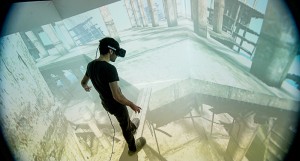In one of my previous posts I mentioned a phenomenon called presence, which is a potent experience capable of convincing a person that they occupy a place which they do not exist physically. This experience is difficult to describe but is the quintessential point I, and other researchers in the field of virtual reality, believe the technological and the therapeutic intersect. This post will attempt to explain how presence is achieved and how it can be therapeutic.
Presence, in terms of artistic experience, is also called immersion, explained by philosopher, Samuel Coleridge, as a “suspension of disbelief”. This experience can occur in any medium, such as a good book, or a tv show. If you can imagine a quiet evening with a book where an exciting story can make you forget that you have been turning the page for hours. This is an example of immersion. You feel as though you are a visitor to the story, or a witness to the events unfolding in your minds eye. What virtual reality (VR) accomplishes is immersion but replacing the minds eye with direct visual input.
Presence is achieved through VR by completely encompassing the observer’s eyes through a screen within a headpiece. Using positional tracking, or the ability for the image to pan with the observer’s movements, the moving image allows for the feeling of visual immersion, moving with the observer’s gaze convincingly through the VR scene. This simple experience can be powerful enough to create a sensation of motion, scale, and can even elicit emotional states.
The VR community, made up of technology enthusiasts, entrepreneurs, and researchers like myself, have been curious about the psychological effects of VR. For example, one of the more popular genres of VR experiences is horror. Fear is an emotion that is easy to evoke in the VR space. A scene can be made primarily of shadows, textures, and ambient noise, creating an atmosphere where the observer infers danger near by, and the mysteries of the unknown is enough to get the heart racing. Putting on a set of headphones to drown out distractions only amplifies any immersion. Now, if VR can induce such a strong fight or flight response, what other emotional or physiological responses can we evoke, and to what degree? Could we evoke happiness, sadness, anger, or love to the extent where we can experience our emotions recreationally? I believe that we have already accomplished an impressive degree of presence through novels and films. What VR can bring is a visceral and digital extension to our immersion into the arts, but instead of interpreting experiences, we will now be able to select and experience them directly.
*The views expressed by our authors are personal opinions and do not necessarily reflect the views of the CCPA
